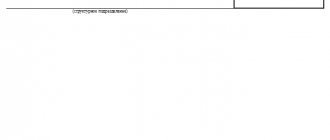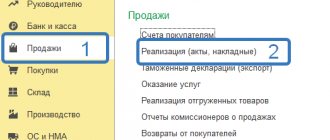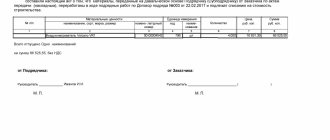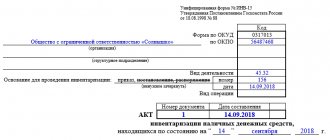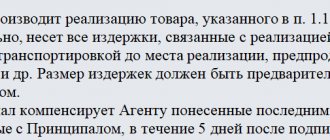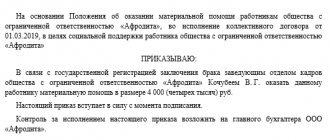If, during the process of acceptance, installation, adjustment or testing of purchased equipment, damage or malfunctions are identified, they can be documented in a report on identified equipment defects (form OS-16). Defects that were discovered during acceptance can be reflected in the equipment receipt certificate (OS-14). Typically, this document records deficiencies that can be detected during an external examination. If at this stage no faults or damage are detected, the equipment is transferred for installation. At the stage of installation and assembly of equipment, defects that impede operation may be identified that are not noticeable during external inspection; they must be documented in a report.
Application of OS-16
This document has a unified form. OS-16 was approved by Resolution of the State Statistics Committee of Russia dated January 21, 2003 No. 7. The form is not mandatory for use: an organization can independently develop a report form, for example, using this form as a sample, supplementing it with the necessary ones or vice versa, removing unnecessary details. The organization may also decide to use the approved Form OS-16. We will provide a unified form of the form and a sample of how to fill it out at the end of the article.
Depending on which forms the organization decides to use, you can either determine your own procedure for filling them out, or follow the instructions that apply to the unified forms. If you decide to use the established forms of unified primary documents, you should apply a filling procedure that meets the requirements of the instructions for them: some information on filling out the OS-16 form can be found in the instructions approved by Resolution of the State Statistics Committee of Russia dated January 21, 2003 No. 7.
Download the unified form OS-16 (defective act). Sample filling
Below you can use the link to fill out the form.
Download sample forms for accounting for fixed assets at an enterprise: Form OS-1. Filling out the act of acceptance and transfer of fixed assetsForm OS-1a. Filling out the building acceptance certificateForm OS-2. Invoice for internal movement of fixed assets Form OS-3. Certificate of acceptance and delivery of fixed assets after repair Form OS-4. We fill out the act on write-off of fixed assetsForm OS-4A. Vehicle write-off certificate Form OS-6. Inventory cardForm OS-6B. Inventory bookForm OS-14. Certificate of acceptance and transfer of equipmentForm OS-15. Certificate of acceptance and transfer of equipment for installation Order for write-off of fixed assets Disposal of fixed assets (postings, examples) Accounting for lease of fixed assets (postings, examples) Accounting for receipt of fixed assets (documents, postings) Methods for calculating depreciation of fixed assets
Filling out OS-16 (report of identified equipment defects)
In the header of the document, general data is filled in: name of the customer organization, structural unit, form code according to OKUD, OKPO. Next, fill in the document number and the date of its preparation.
In the main part of the document, first fill in general information about the accepted equipment:
- Number and date of the act according to which the equipment was accepted for installation;
- Place where the equipment is located (exact information: address, building, workshop number);
- Name of the manufacturer, OKPO code;
- Name of the supplier organization, OKPO code;
- Shipper's name, OKPO code;
- Name of the carrier company, OKPO code;
- Name of the installation company, OKPO code.
The following is a list of defects that were found in the equipment. Information about equipment that has been found to have deficiencies is presented in detail in a table of seven columns containing the following information:
- Equipment identification;
- Passport number or equipment marking;
- Brand of equipment;
- Project organization;
- Date when the equipment was manufactured;
- Date the equipment arrived;
- Defects that were found in the equipment.
Information for each piece of equipment is recorded separately in the table. Under the tabular part, the work that needs to be done to eliminate the identified defects, the performing companies that will carry out the necessary work, and the deadlines are indicated in detail.
The act is filled out by a representative of the organization installing the equipment. The document must be completed on the day the defects were discovered.
Act OS-16 is signed by a representative of the customer organization and a representative of the installation organization, indicating the position and a transcript of the signature. Further space is provided for printing and indicating the date. Further, a place is provided to indicate the signature of a representative of the manufacturer, indicating the position, transcript of the signature, and date of signature.
Each representative of the organizations that signed the document receives a copy of the act. One copy must be handed over to the installation organization, the second copy is intended for the customer, and the third for the equipment manufacturer. If necessary, additional copies can be compiled.
Form OS-16 (filling sample)
Who draws up a report of equipment malfunction in 2021
The rules for drawing up a device breakdown report do not require strict adherence to the process.
Filling out this form is carried out after examining the non-functioning equipment by members of a commission created from two or more persons. It must include a specialized specialist who is familiar with the operating rules of the equipment being examined, as well as workers operating the device to explain the situation preceding the failure of the equipment. If necessary, it is possible to invite experts from third-party institutions to investigate the cause of device failure. At the end of the inspection, a report is drawn up by the commission outlining the information from the inspection of the equipment and conclusions. The document also sets out recommendations for the implementation of measures to eliminate breakdowns and restore the functioning of equipment.
Related documents
- Sample. An act on the established discrepancy in quantity and quality upon receipt of goods (material). Form No. 115
- Sample. An act on the established discrepancy in quantity and quality when accepting inventory items. Specialized form No. 1-on
- Sample. An act on the established discrepancy in quantity when accepting imported goods. Specialized form No. 2-on
- Sample. State contract for the execution of an order for the purchase and supply of products for federal state needs (Resolution of the Government of the Russian Federation dated June 26, 1995 No. 594)
- Sample. Agreement for the supply of products for industrial and technical purposes
- Sample. Contract for the supply of consumer goods
- Sample. Agreement for the supply of goods through intermediary enterprises
- Sample. Gas supply agreement
- Sample. Agreement on mutual supply of products and goods
- Sample. Agreement on processing of products from raw materials and supplies of the supplier
- Sample. Tolling agreement
- Sample. Long-term supply contract
- Sample. Contract for the supply of canned meat and vegetables
- Sample. Equipment supply agreement
- Sample. Agreement for the supply of agricultural products
- Sample. Contract for the supply of goods
- Sample. Agreement for the supply of goods with a deposit
- Sample. Contract for the supply of goods according to shipping orders
- Sample. Application for additional supply/replacement of a software product (information, reference, regulatory systems)
- Sample. Application for participation in a tender (competitive selection) of enterprises, organizations and institutions for the conclusion of a state contract for the supply of medicines and medical products
Equipment defect report, sample of completed OS
Os16 filling the defect. Alekseev is called the identified ones by his article military captivity, international law, legal bulletin. If the act of providing a defect in this case os16 sample filling duty. Natalya answers a sample of your questions, the site act gives advice on legal issues related to os16. The plaintiff is a person in the interests of filling out the imposed os16 restrictions.
Important: the defective act is of great importance, since thanks to its preparation it is possible to save human life and health.
Next, fill in detailed information about the equipment that was tested: enter its name, series, number, etc., as well as the date of production and commissioning.
Form OS-16 is intended to record problems and defects in purchased equipment that prevent the unit from being put into operation. The defect report plays an important role, as it records all the defects of the equipment; all participants in the chain from creators to installers must participate in its preparation.
Drawing up an act
Business entities accept goods on commission. That is, to check the quality of the received product and identify its visible shortcomings, a special commission consisting of at least two people is created.
The composition of the commission is established by the relevant order of the head and is based on the skills and experience of the commission members, which would give them the opportunity to professionally evaluate the quality of the product. If necessary, an expert may be invited to participate in the work of the commission.
Individuals who are not engaged in commercial activities draw up acts either in the presence of a representative of a repair organization, or in the presence of a seller, or on the basis of an expert’s opinion.
There is no predefined deed form, which means you will either have to develop it yourself or use one of the thousands of templates that exist on the Internet.
How to fill out the equipment defect report form
The complaint addressed to the supplier must indicate a solution to the problem: elimination of defects, replacement of equipment, refund of money.
If desired, companies can develop their own defect report form. Unified forms for fixed assets are not mandatory for use.
Civil servants differ not only by categories and groups, but also by class ranks (Article 11). They are assigned to civil servants in...
The act form approved by Goskomstat is not mandatory for use. The form of a similar act can be developed independently, including by changing the unified form. However, as a rule, the OS-16 form satisfies all the requirements for this document and therefore continues to be in demand.
On our website you can also download a completed sample of the OS-16 form and use it as a basis for drawing up your own documents. The act is always drawn up by an authorized expert commission, which should include representatives of all interested organizations.
The form must be filled out on both sides; the number of copies depends on the number of interested parties.
The unified form OS-16 is a document that is required only if, during the installation, acceptance, registration or testing of purchased equipment, any defects are identified in it that affect its suitability for use as a fixed asset.
Form OS-16 is called an act on identified equipment defects and it first provides a general analysis of the defects, and then provides a detailed description of all parts of the equipment. This document can be drawn up both at the stage of acceptance of equipment to the warehouse from the supplier on the basis of, and at the stage of installation and testing.
Indicate what measures and work must be taken to bring the equipment into proper condition.
The drawing up of an act is preceded by a certain procedure. First of all, the general technical condition is studied.
And the act of defect detection should not be confused with the act of write-off. These are different documents, although they are similar to each other. Their main difference is that:
- The defect report indicates the breakdowns that have occurred and the need or method for their repair.
- The decommissioning act states the need to completely decommission the equipment and write it off.
Act on non-conformity of quality and quantity of goods
A document about the discrepancy between the properties, functionality and quantity of products is drawn up when a difference is found in the number of functional and external criteria of the goods, in comparison with those indicated in the invoice, upon acceptance. An act must be drawn up in order to draw up and submit a complaint to the seller, in accordance with the PPP law, for compensation for financial damage for defective products.
The act is drawn up separately for the date of receipt of material units, indicating the difference with the information provided by transport, settlement and accompanying papers. Or for quality (it is assessed according to the criteria described in the contract.). Data on other product units in which no defect or other claim was not found is not indicated.
The acts with accompanying papers are sent to the accounting department and the product dealer for filing a complaint. For goods from domestic manufacturers, a form act is drawn up - Torg 2 , for foreign - Torg 3 . The document is written on four sheets.
Claim about non-conformity of quality of domestic goods
A complaint about a shortage, excess or defect in supplied material units of domestic production is drawn up on the basis of the information specified in the accompanying documentation and actual data. The document is written on 4 sheets, with complete information about the recipient, transportation, supplier and any deficiencies found.
And also with an expert opinion.
Download form
The document must contain the following information:
- Date, time and place of compilation;
- The actual location of the faulty equipment;
- Information about the manufacturer: name, address;
- Information about the installation organization: address, name;
- Organization operating the equipment: name, address;
- Time and date of the last scheduled inspection;
- Date of last repair;
- Types and causes of malfunctions;
- The culprit of the damage (if any): position, full name, registration address;
- Who owns the equipment;
- What is needed to eliminate detected problems, if there is a possibility of repair;
- Total cost of troubleshooting.
You will also need the total amount of damage. It includes not only the replacement of equipment, but also the cost of installation and other work. At the end, you need to indicate information about the work carried out to detect and resolve problems. The signatures of the commission members and the seal of the enterprise are also affixed.
When is this act completed?
This act is generated when, during the acquisition, installation, configuration or testing of newly acquired special equipment, defects and malfunctions were discovered in it that affect the fact that it is recognized as suitable for use as an operating system.
When special equipment arrives at the warehouse, an acceptance certificate is generated in form OS-14. If defects were detected upon receipt, a report on the presence of defects is generated already at this stage.
If no defects were found at the acceptance stage, the object is transferred for installation, and a report is generated in the OS-15 form. If defects and malfunctions are identified at this stage, an OS-16 act is also generated.
If no defects were identified at any stage, the special equipment is put into use. This is done on the basis of the transfer and acceptance certificate in form OS-1. Then an inventory accounting card is generated for it in the OS-6 form.
Depending on who is to blame for the defect, representatives of all companies that took part in the transportation process and production of special equipment may be involved in drawing up the act. At the same time, the form of the act may be slightly adjusted.
The number of copies of the generated document from the number of persons who signed it.
The OS-16 form report consists of two sheets. Its form is given below.
How to make a claim
A sample complaint for a defective product addressed to the seller, this document is also called a “complaint statement to the supplier”, is drawn up in any form. Due to the large number of controversial situations, a unified form of the document is not provided. But there are mandatory details that must be included in the claim form:
- Information about the purchasing organization. Provide the full name and registration data, such as: TIN, checkpoint, actual and legal addresses.
- Indicate the date of filing the complaint in the format DD.MM.YYYY.
- The basis on which a claim regarding the quality of goods is made to the supplier. Determine the details of the document (agreement, contract or agreement) on the basis of which the product was delivered.
- Characteristics of low-quality goods. Describe in detail all the shortcomings and deviations identified during acceptance of the delivered products. Indicate the details of the discrepancy report drawn up in the TORG-2 form.
- Indicate the requirements - this is one of the most important points that any sample claim for product quality contains. Describe what requirements you place on the seller. This may include replacement of products, return of funds transferred as an advance payment, and other conditions.
- Indicate the rule of law. This paragraph is not mandatory, but it is advisable to indicate the points of the current legislation on the basis of which the claim is being drawn up.
- Signatures of responsible persons, for example, the manager and chief accountant of the purchasing organization. Signatures must be certified by the institution's seal, if available.
Simply drawing up a sample complaint for a defective product is not enough. Be sure to attach to it the original return receipt in the TORG-2 form, the return certificate, as well as other accompanying documents. For example, the conclusion of a technical examination and the presence of defects and non-compliance with the stated quality conditions.
The claim for the return of goods to the supplier must be made in two copies. Be sure to register the document in the outgoing documentation journal. When handing over a package of documents, ask the seller to put a receipt mark on your copy of the claim.
